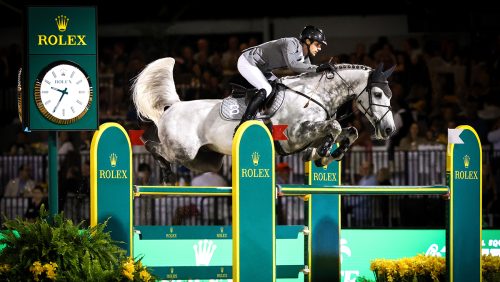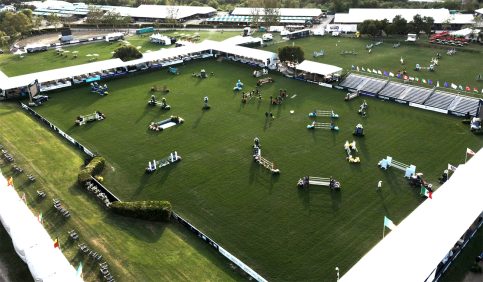Wellington, Fla.—Feb. 23
FEI Jumping Committee Chair John Madden stood up at the North American Riders Group Annual Meeting Feb. 23 at the Wanderers Club in Wellington and had the undivided attention of the packed room of horsemen.
“It was a great natural thing that NARG got this [horse show] evaluation thing going,” he said, speaking of the annual NARG Top 25, a list of the top 25 horse shows in North America, which recognizes the best shows on the continent and encourages them to raise their competition standards.
“The NARG Top 25 has instigated major change in our sport and has effected the way exhibitors and management think about competition standards,” NARG board member Murray Kessler said. “It has proven that comparing events via competitive ranking and suggestions really works.”
But NARG announced Tuesday night that the organization is taking a hiatus from the Top 25—indefinitely—and relegating the task to the governing bodies of the Fédération Equestre Internationale and U.S. Equestrian Federation.
“As this objective and subjective evaluation of events gets more and more important, it’s not probably the place of a lobbying group—which NARG is—to do that,” Madden said. “It probably is the place for the international federation and the national federation to do this in their very objective, albeit partially subjective, way, with input from all of the stakeholders as to actually what the evaluation should be. Luckily, the FEI has put a lot of time and effort into it, and it’s up and running now. It’s called the ECS—the Event Classification System.
“What I see is a really good collaboration between NARG, the USEF and the FEI moving forward,” he continued, “so we can be able to measure all of our events in a very meaningful way that’s defensible, whether it be date clashes or for raising levels or star levels, or whatever it be for.”
The NARG Top 25 has been in place for six years. According to NARG, 26 venues have improved footing during that span, 13 venues have improved stabling, 19 events have increased their number of world ranking classes and prize money, and three new Nations Cup events have been added. Moreover, the number of five-star events in North America has increased from four to 17—and from one to 12 five-star events in the United States—since 2010.
“We hope this really does take hold, and if it doesn’t, we’ll be back,” Kessler said.
Influencing Rule Changes
One major point was driven across at the meeting: Change is coming for the organization, which is evolving to more greatly focus its efforts on “infiltrating governing bodies” so that North American riders have “a seat at the table” to influence rule changes and represent North American rider interests on a national and global scale. Currently, NARG president Chris Kappler, Kessler and Beezie Madden hold positions within the USEF, and Lauren Hough, Kent Farrington and Tiffany Foster are International Jumping Riders Club board members within the FEI.
ADVERTISEMENT
“We want to actually influence rule changes that are important to riders and owners and trainers,” Kessler said.
NARG is encouraged by its results thus far. In 2015, the group played a major role in changing USEF vaccination rules, supporting the new Longines FEI World Cup Jumping North American League, getting the Pan American Games show jumping more on par with the level of the European Championships, and influencing the complete rewrite of Chapter 3 rules on competition licensing, better known as “the mileage rule.” Previously, the mileage rule created what NARG members deemed a monopoly on horse shows, which resulted in overcrowding and high entry fees.
With the rewrite, the term of competition licenses has been decreased from three years to one year, and exemptions can be made to break the mileage rule “if it is justified.” “Special Competitions” such as the Pan American Games, the Olympics and CSI5***** events, are exempt from the mileage rule. Other conditions based on competition standards, competition and calendar factors, and sport growth and visibility can also cause a competition to be exempt from the mileage rule. The announcement of the changes resulted in a wild eruption of applause from those in attendance.
The mileage rule exemption was tested on Feb. 4-7 in Wellington, when the Wellington Masters CSI3*-W took place at Deeridge Farms at the same time as the fourth week of the Winter Equestrian Festival, a CSI 4**** competition. The two competitions were within a mile of each other, with some riders commuting back and forth to ride two grand prix classes in the same day.
“Had it been evaluated [in 2015], it would have been a top-seven rated event on the NARG Top 25,” Kessler said of the Wellington Masters. “And the numbers were still huge at WEF.”
Linking Grassroots Sports To The Elite Level
USEF Sport Director Will Connell was the guest speaker on the evening, and he presented an engaging presentation on improving high performance equestrian sport in North America. Formerly the British Equestrian Federation Performance Director, the European native added a light-hearted feel to the evening with sharp one-liners, jokes and good-natured pokes at himself.
But he made some great points. He started a discussion about where coaching is going in the United States, stressing the importance of creating a coach register, a coaching manual (which Connell said would “not [be] easy”) and elite coach development programs to “help our very best coaches be better still.” The goal is to improve both coaching quality and rider safety at all levels of the sport.
“In any sport, coaches are central to the development of the sport at all levels,” Connell said. “If we don’t start the conversation now, we’ll be sitting here in 15 years wishing we had. Every level of the sport should have a level of expectation, right through to the person that is going to deliver gold medals at the Olympics.”
Connell also said that a goal of his is to better link grassroots riding to the elite levels of the sport as well as to improve the young horse programs in the United States. He showed a pyramid diagram illustrating the segmentation and segregation of amateur riders from professional riders and elite riders.
“We need to create a pathway for people to move up the sport or get supported at the level they want to compete,” he said.
ADVERTISEMENT
Top 25
There were changes to the NARG Top 25’s ranking system for the 2015 evaluations, as the point scale was adjusted from a five-point scale to a more difficult 10-point scale, which resulted in lower scores across the board for all the evaluated shows. But that didn’t stop Spruce Meadows (Alberta) from topping the list for a sixth consecutive year with an 88 percent score.
“Spruce Meadows is truly in a league of their own,” Tiffany Foster said. “The reason that they are so good is that they continue to strive to be better.” Spruce Meadows has increased prize money and will have four CSI 5***** tournaments during its summer series in 2016.
Spruce Meadows’ founder Ron Southern passed away in January at the age of 85. His grandson and Canadian show jumper Ben Asselin accepted the award in his absence, and a moment of silence was held early in the meeting in Southern’s memory.
“I know that my grandfather would be very humbled and proud to be here,” Asselin said. “On behalf of the entire Spruce Meadows team and my family, thank you very much.”

Ben Asselin (second right) accepted the award for Spruce Meadows as NARG’s top-rated horse show from Lauren Hough (left) and Tiffany Foster.
Thunderbird (British Columbia, 81%), the Royal Horse Show (Toronto, 81%), the Los Angeles Masters (Calif., 80%) and the Global Champions Tour Miami Beach (Fla., 79%) rounded out the top five. For the complete list of NARG’s Top 25 horse shows of 2015, click here.
The New Albany Classic (N.Y., 84%) was named the top specialty event over the Trump Invitational (Fla., 73%), the Central Park Horse Show (N.Y., 69%) and the NAJYRC (Ky., 68%). Matt Morrissey of Stadium Jumping was on hand to accept the award on behalf of the New Albany Classic, and he announced that over the last 18 years, the show has raised over $20 million for the Center for Family Safety and Healing.
Zazou Hoffman was awarded the NARG Riders Group Grant, a $15,000 grant “designed to enable a rider dedicated to the sport of show jumping an opportunity to achieve levels of performance they otherwise may not have been able to attain.” To learn more about how the hard-working Hoffman is making the transition to being a professional and climbing the grand prix ranks after winning the 2009 ASPCA Maclay Finals, check out the March 7 issue of the Chronicle. More on this year’s NARG Top 25 will be in the March 21 Horse Show issue of the Chronicle.
The final announcements of the evening revolved around changes to the NARG Board of Directors. Mark Leone joined the board, and Will Simpson was re-elected with 95 percent of the vote.
Murray Kessler and Beezie Madden are leaving the NARG board. Kessler is stepping away to take on more responsibility with USEF, as he is currently on the USEF Governance Committee. Madden, meanwhile, will focus her efforts on supporting the “eight or nine task forces” she is on this year.
“I will continued to be a NARG member and help in any way I can,” Madden said. “Maybe in the future I will run again to get back on the board.”















